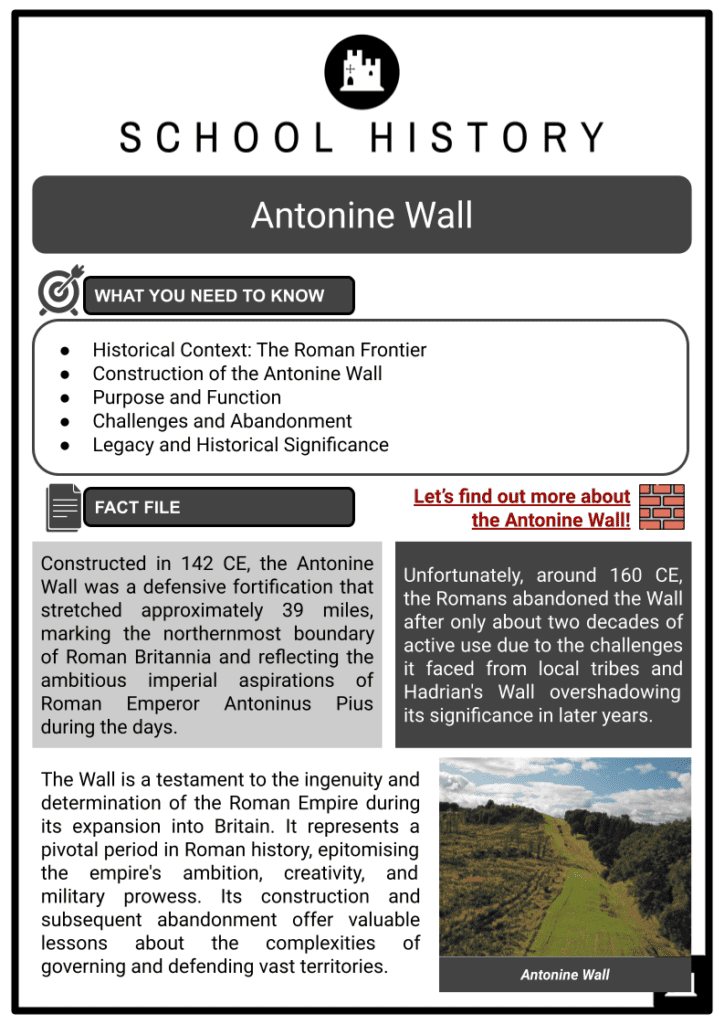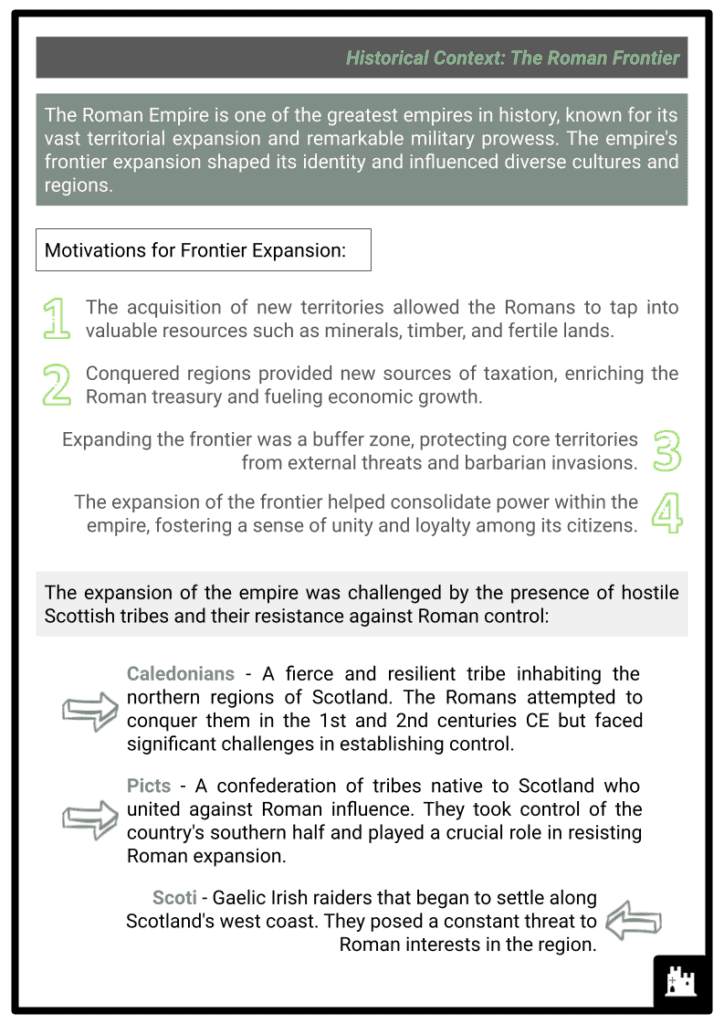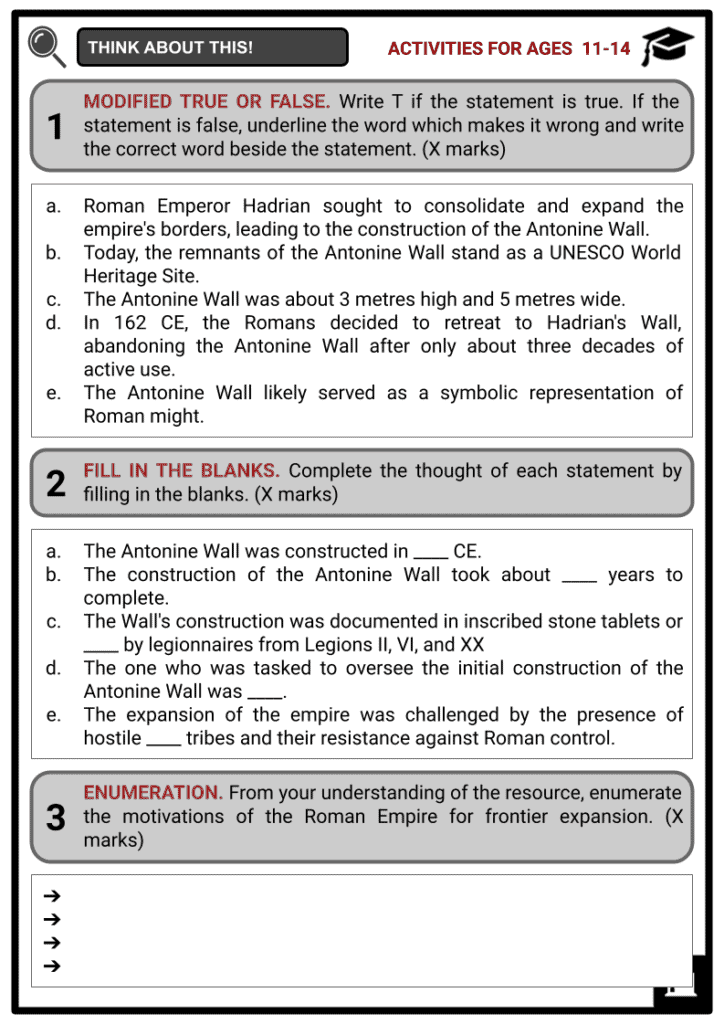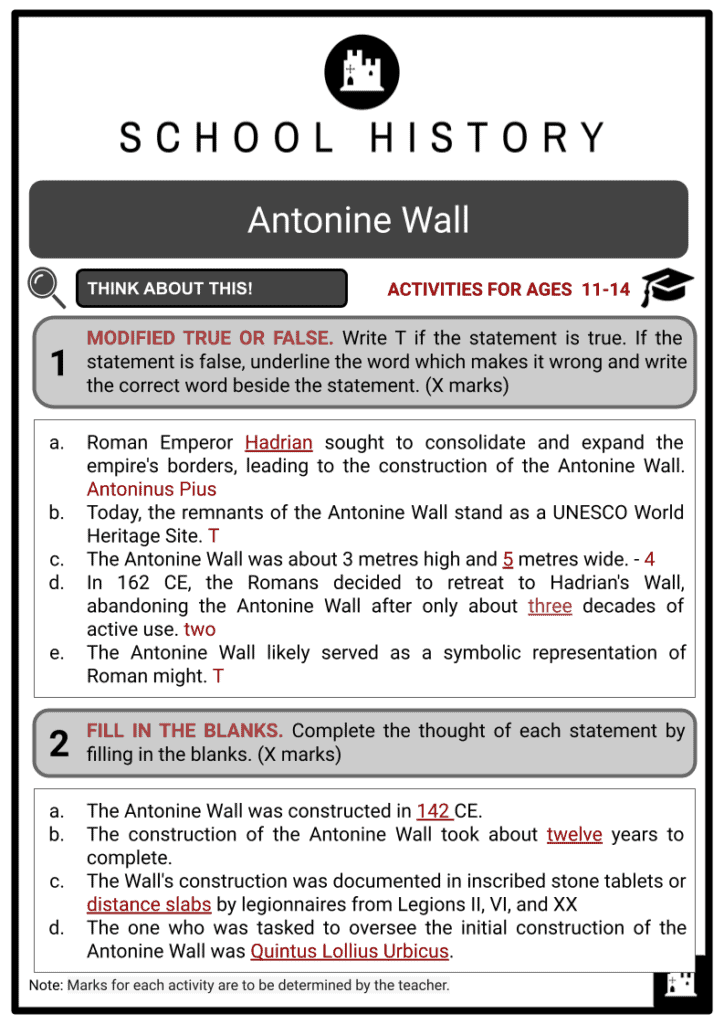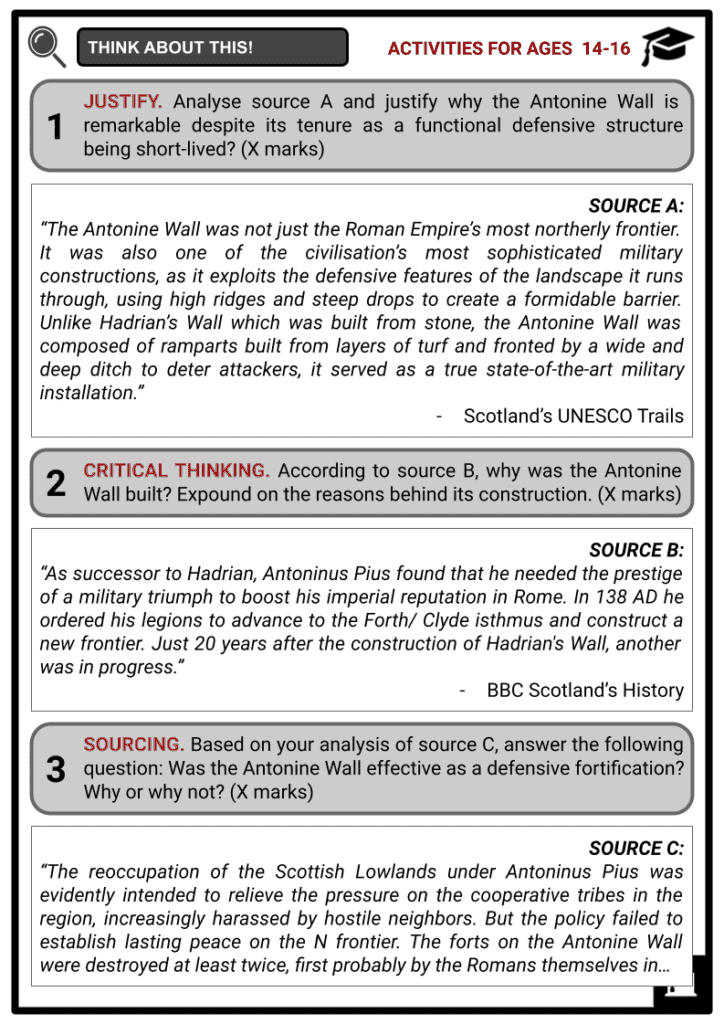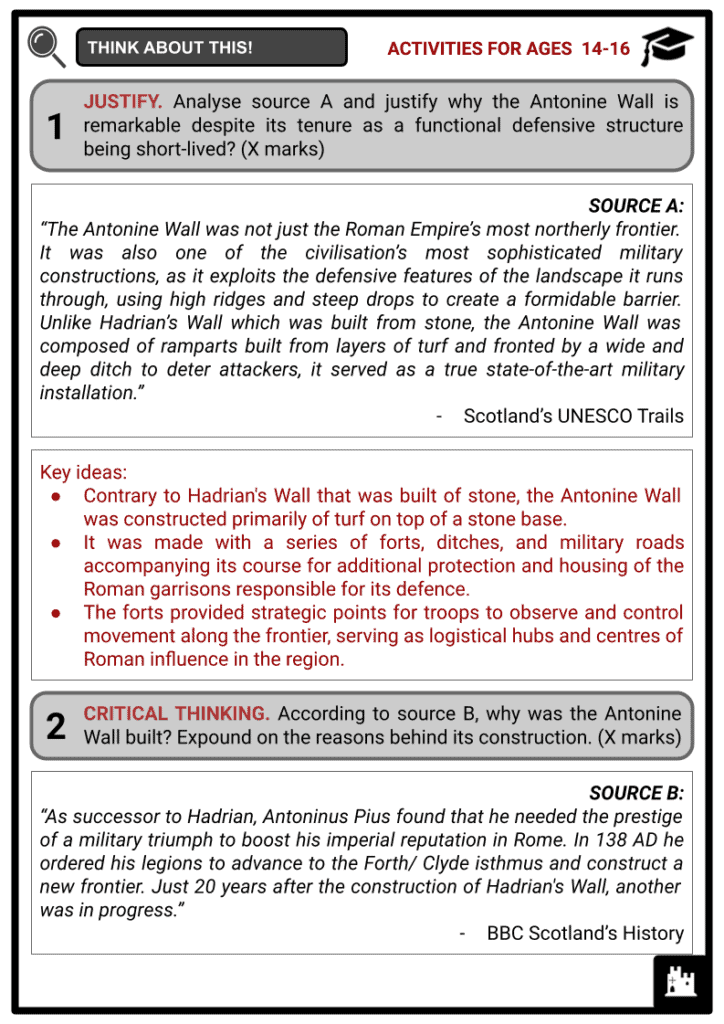Antonine Wall Worksheets
Do you want to save dozens of hours in time? Get your evenings and weekends back? Be able to teach about the Antonine Wall to your students?
Our worksheet bundle includes a fact file and printable worksheets and student activities. Perfect for both the classroom and homeschooling!
Summary
- Historical Context: The Roman Frontier
- Construction of the Antonine Wall
- Purpose and Function
- Challenges and Abandonment
- Legacy and Historical Significance
Key Facts And Information
Let’s find out more about the Antonine Wall!
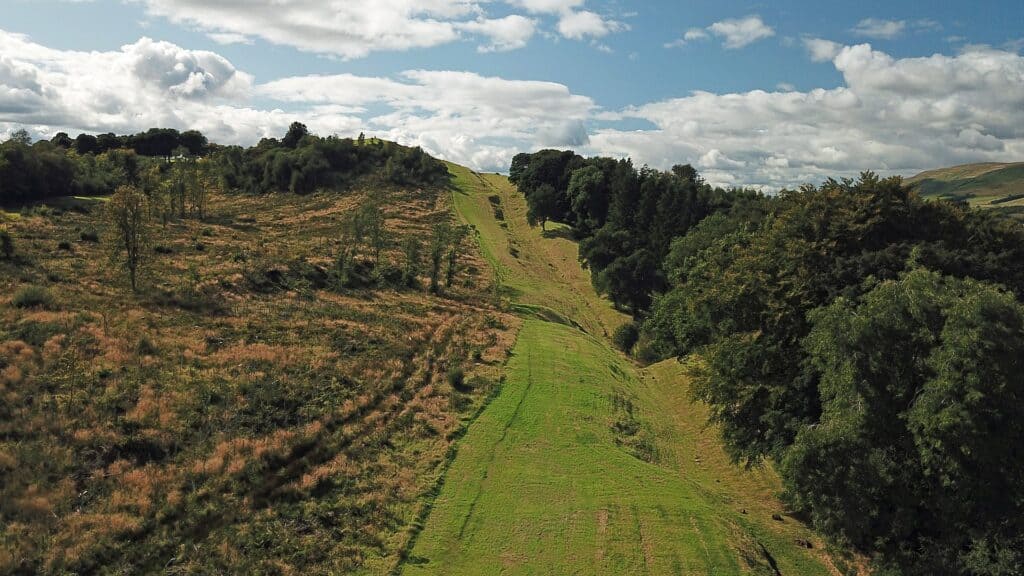
Constructed in 142 CE, the Antonine Wall was a defensive fortification that stretched approximately 39 miles, marking the northernmost boundary of Roman Britannia and reflecting the ambitious imperial aspirations of Roman Emperor Antoninus Pius during the days. Unfortunately, around 160 CE, the Romans abandoned the Wall after only about two decades of active use due to the challenges it faced from local tribes and Hadrian's Wall overshadowing its significance in later years. The Wall is a testament to the ingenuity and determination of the Roman Empire during its expansion into Britain. It represents a pivotal period in Roman history, epitomising the empire's ambition, creativity, and military prowess. Its construction and subsequent abandonment offer valuable lessons about the complexities of governing and defending vast territories.
Historical Context: The Roman Frontier
- The Roman Empire is one of the greatest empires in history, known for its vast territorial expansion and remarkable military prowess. The empire's frontier expansion shaped its identity and influenced diverse cultures and regions.
Motivations for Frontier Expansion:
- The acquisition of new territories allowed the Romans to tap into valuable resources such as minerals, timber, and fertile lands.
- Conquered regions provided new sources of taxation, enriching the Roman treasury and fueling economic growth.
- Expanding the frontier was a buffer zone, protecting core territories from external threats and barbarian invasions.
- The expansion of the frontier helped consolidate power within the empire, fostering a sense of unity and loyalty among its citizens.
The expansion of the empire was challenged by the presence of hostile Scottish tribes and their resistance against Roman control:
- Caledonians - A fierce and resilient tribe inhabiting the northern regions of Scotland. The Romans attempted to conquer them in the 1st and 2nd centuries CE but faced significant challenges in establishing control.
- Picts - A confederation of tribes native to Scotland who united against Roman influence. They took control of the country's southern half and played a crucial role in resisting Roman expansion.
- Scoti - Gaelic Irish raiders that began to settle along Scotland's west coast. They posed a constant threat to Roman interests in the region.
- Following the successful invasion of Britain by Emperor Claudius in 43 CE, the Romans established control over most of the southern part of the island, with the established border being Hadrian's Wall, constructed by Emperor Hadrian during the 2nd century CE.
- However, as Roman control extended further north, Emperor Antoninus Pius, who succeeded Hadrian, sought to consolidate and expand the empire's borders, leading to the construction of the Antonine Wall in 142 CE.
Construction of the Antonine Wall
- With a labour force of around 7000 men, the construction of the Antonine Wall took about 12 years to complete as it required meticulous planning and engineering expertise. Quintus Lollius Urbicus, a governor from North Africa, was tasked to oversee the initial construction of the Wall.
- It stretched approximately 39 miles across the narrowest part of modern-day Scotland, running from modern Old Kilpatrick on the River Clyde on the west coast to Bo'ness on the Firth of Forth in the east.
- The Wall was about 3 metres high and 4 metres wide, made of turf, stone, and timber, with a series of forts, ditches, and military roads accompanying its course for additional protection. A timber barrier and an army road reinforced it.
- Unlike Hadrian's Wall, which followed a more east-west alignment, the Antonine Wall ran in a predominantly southwest-northeast direction to establish a new frontier and exert Roman authority beyond Hadrian's Wall. The Antonine Wall's fortification was also shorter and more straightforward. Contrary to Hadrian's Wall that was built of stone, the Antonine Wall was constructed primarily of turf on top of a stone base.
- Along the Antonine Wall, a series of forts and fortlets were established to house the Roman garrisons responsible for its defence. The Wall included at least 17 forts (out of 19 forts) and several intermediate fortlets. These forts provided strategic points for troops to observe and control movement along the frontier, serving as logistical hubs and centres of Roman influence in the region.
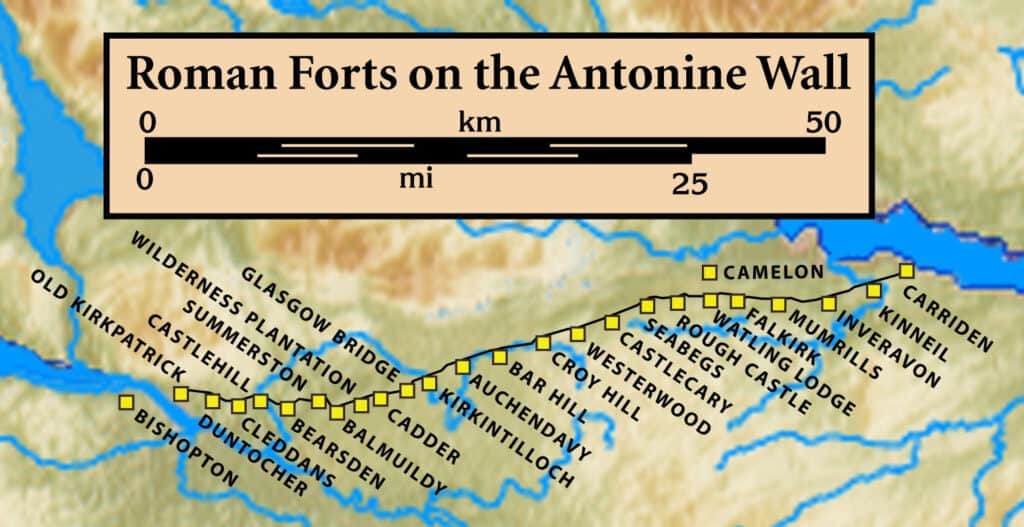
Forts and Fortlets associated with the Antonine Wall - The Wall's construction was documented in nineteen inscribed stone tablets or distance slabs by legionnaires from Legions II, VI, and XX. These stones honour Emperor Pius and record the name of the responsible legion and the distance of the wall sections.
- The Wall's design and fortification emphasised the Roman military's ability to project power and control the northern territories of Britannia.
Purpose and Function
- The primary purpose of the Antonine Wall was to serve as a physical and psychological deterrent to potential invaders, particularly the northern tribes, such as the Caledonians and the Picts. The Wall aimed to establish Roman control over the regions of the north of Britain and maintain peace and security within the Roman province.
- By extending the border northwards, the Romans aimed to establish a new line of defence and exert greater control over the region. It also facilitated the efficient movement of Roman troops and supplies along its length, allowing for quick responses to any threats that may have arisen.
- Aside from being a military structure, the Antonine Wall was a thriving community. Soldiers along the Wall lived in forts and fortlets, while civilians, such as merchants and artisans, settled in the surrounding areas. Roman forts and settlements along the Wall led to establishing trade routes, enabling the flow of goods and ideas between different regions.
- Roman settlements brought agriculture, technology, and infrastructure advancements, influencing the local populations. Similarly, the indigenous tribes contributed their cultural practices and resources, creating a unique blend of Roman and native traditions.
- Additionally, the Antonine Wall likely represented Roman might and the Emperor's ability to expand the empire's boundaries. It became a testament to Roman engineering prowess and a reminder of their ability to dominate foreign lands.
Challenges and Abandonment
- The effectiveness of the Antonine Wall as a boundary between Roman Britain and northern tribes was complex. Its tenure as a functional defensive structure was relatively short-lived.
Construction Challenges
- The construction of the Antonine Wall was a challenging task. The harsh Scottish terrain, characterised by marshes, hills, and rocky landscapes, posed significant challenges.
- The Romans had to overcome these obstacles, often resorting to manual labour and harnessing the skills of skilled artisans. The Wall required extensive planning, engineering expertise, and significant resources, which strained the Roman Empire's capabilities.
Maintenance and Defense
- While it provided some security against incursions, some conflicts and interactions occurred along the border of the Wall. The northern tribes frequently launched raids and attacks against the Roman fortifications, causing constant tension and conflict.
- Maintenance and defence of the Antonine Wall presented ongoing challenges for the Romans. With the Wall vulnerable to attacks from the tribes, the Romans had to station many troops along the Wall's length, diverting resources from other parts of the empire.
- This strain on military resources and the constant threat of raids made it increasingly difficult to maintain the Wall's integrity.
Economic and Political Factors
- The Roman Empire faced economic and political challenges that impacted the Antonine Wall's fate. The Romans deployed military forces along its length to maintain control over northern territories beyond the Wall. Garrisons, forts, watchtowers, and other military installations dotted its path, ensuring constant surveillance and quick response times in case of any threats or disturbances.

The easternmost distance slab - However, the cost of maintaining such an extensive defensive system proved burdensome for the empire. The empire struggled with financial strain and unrest on various fronts. The need to maintain a vast network of fortifications across the kingdom, including Hadrian's Wall, competed with the resources required for the Antonine Wall. Additionally, political instability within the empire diverted attention and resources away from the Wall's upkeep.
Shift in Roman Strategy
- In 162 CE, the Romans decided to retreat to Hadrian's Wall, abandoning the Antonine Wall after only about two decades of active use. Although the precise cause of this is unknown, it is thought that the Romans may have been under pressure from tribal attacks on other fronts. They may have also felt that maintaining the Wall was no longer worthwhile due to financial constraints and political unrest.
- As Emperor Hadrian's reign progressed, Rome shifted its focus back towards consolidating their hold on established territories rather than expanding further north. The Antonine Wall's abandonment went against the Roman Empire's approach to frontier defence, prioritising strategic consolidation over territorial expansion.
Challenges and Abandonment
- Although the Antonine Wall was relatively short-lived, its legacy is a remarkable feat of Roman engineering and strategic planning. It provides valuable insights into the Roman Empire's frontier policy and its methods of controlling vast and diverse territories.
- The Wall's existence and subsequent abandonment also highlight the complexities of maintaining far-flung borders and the challenges of integrating conquered regions into the empire.
- Today, the remnants of the Antonine Wall stand as a UNESCO World Heritage Site. Efforts have been made to preserve and protect it, allowing visitors to explore this remarkable ancient engineering marvel.
- Many of the Wall's remains can still be seen in various parts of Scotland, making it an invaluable archaeological resource. Excavations have provided crucial insights into Roman military architecture, construction techniques, and soldiers' lives along the Wall. The remains of the forts, watchtowers, and associated structures provide valuable insights into the history of the Roman Empire and its interactions with Scotland.
- The Antonine Wall is a remarkable testament to the Roman Empire's engineering prowess, military might, and cultural influence. The Wall represents an enduring link to the ancient past and serves as a reminder of the remarkable achievements of our ancestors.
Image Sources
- https://upload.wikimedia.org/wikipedia/commons/thumb/d/d1/Antoninus_Wall_near_Bar_Hill.jpg/1920px-Antoninus_Wall_near_Bar_Hill.jpg
- https://upload.wikimedia.org/wikipedia/commons/a/a5/Antonine.Wall.Roman.forts.jpg
- https://upload.wikimedia.org/wikipedia/commons/thumb/5/50/Romanwallinscotl00macduoft_raw_0197.jpg/1920px-Romanwallinscotl00macduoft_raw_0197.jpg
Frequently Asked Questions
- What is the Antonine Wall?
The Antonine Wall is a historic Roman defensive fortification in modern-day Scotland, UK. It was built by the Romans in the 2nd CE as a northern boundary to their empire.
- What was the purpose of the Antonine Wall?
The Romans built the Antonine Wall as a defensive fortification and boundary marker in modern-day Scotland. Its main purposes were to deter invasions from northern tribes, assert Roman control over the region, monitor movements, facilitate logistics, and enable cultural interactions.
- Why was the Antonine Wall abandoned?
The Romans abandoned the Antonine Wall due to increased pressure from the northern tribes, logistical challenges, and the decision to focus efforts on defending the older and more established Hadrian's Wall to the south.

